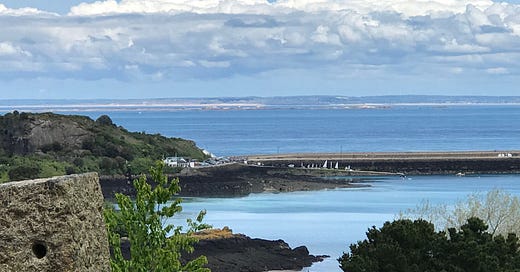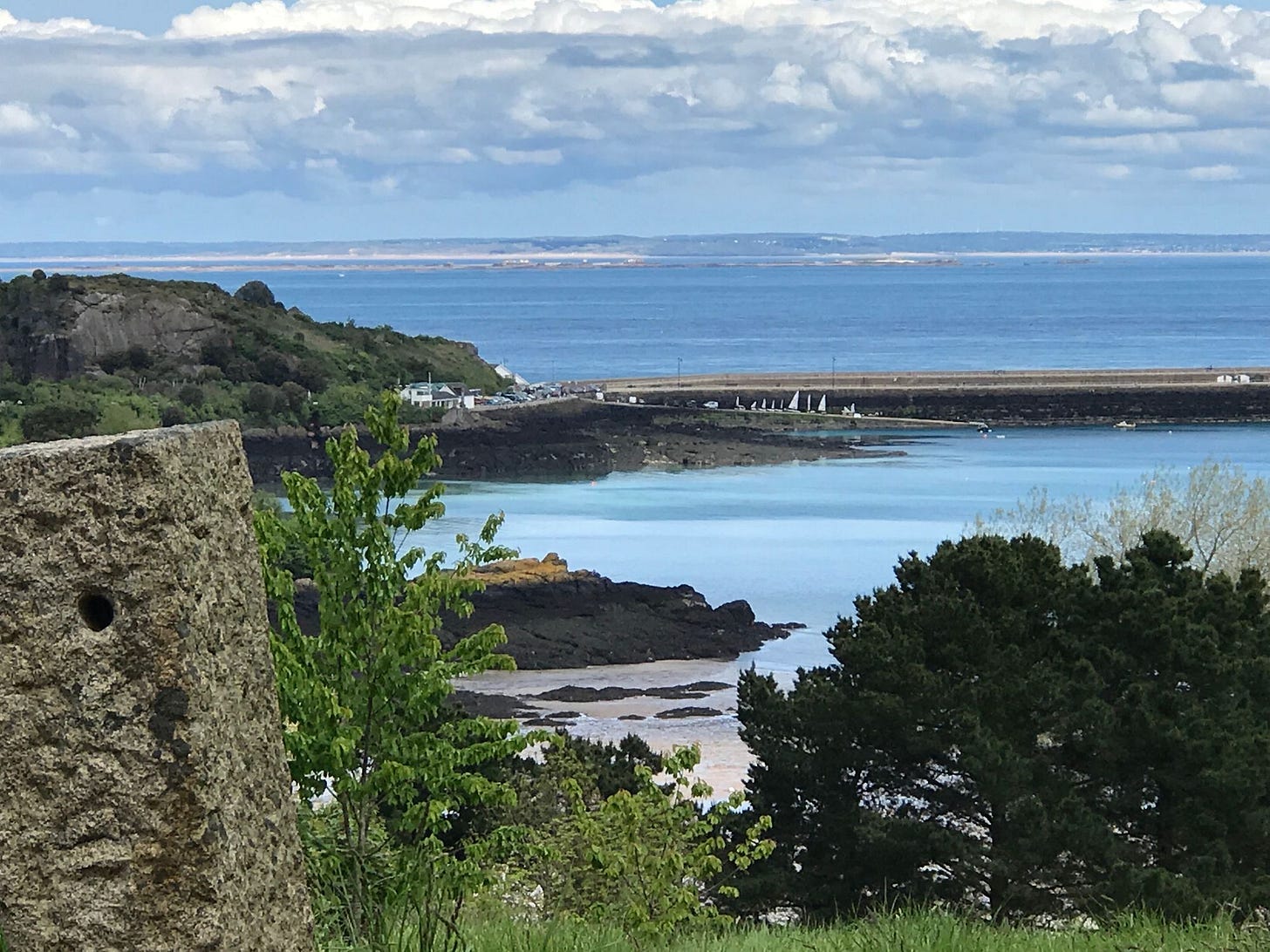The Dragon of St Lawrence
Welcome to the History Islands - your newsletter of Jersey, myths, legends and histories by Paul Darroch.
If you prefer audio, then please follow the History Islands podcasts on Spotify or Apple Podcasts where this story will be appearing soon.
Welcome to this month's Jersey tale. This story is based on a medieval Jersey legend. It most likely arose in the twelfth century, when Jersey was still part of the Duchy of Normandy.
The Isles, they whispered, were stepping-stones, forming a bridge between earth and heaven. They lay far to the west of the Cotentin, in the arms of the setting sun, steps in a celestial ladder that reached from the forest to the skies.
The greatest of them all was Jersey. Latticed by dolmens, barely touched by Roman hands, it remained a hooded and mysterious realm. Sea and land were woven together here. At low tide, the seabed dried to reveal a mosaic of rocks and silent pools. This sandy kingdom would drown as the hourglass emptied, swamped by the flood tide.
The dragon that ruled the island slept by the shores of St Lawrence, where the tides poured in across the bay and collided with the dunes. This was deep and treacherous bogland, a maze of marram grass. Green marsh-fires burned here night and day, ghostly flames dancing over the sands. On moonless nights such as these, the dread beast of St Lawrence would stir.
The dragon crept inside their dreams at first, tormenting the peasant on her straw mat, the fat Seigneur between his ermine sheets. Each sleeper first heard the rhythmic beating of scaly, bony wings, echoing through the chambers of the night. Each dreamer glimpsed its emerald scales, its savage lantern eyes. Sometimes it swooped down like a falcon, lunging at their children, ravaging their precious crops. Sometimes its lightning breath tore up the sky, setting the woods ablaze, exulting when homesteads burned.
Desperate families fled to the stone sanctuary of St Lawrence’s church, barricading the doors, prostrating themselves before the altar until the terror overhead had passed. On brighter days, they tried to forget their creeping fear, pretended it was but a winter’s tale, until the teeth-marks in the barns and the scorched orchards put the lie to their denials.
The dragon was growing stronger, fed by fear. It began to devour a greater portion of the land and razed entire cornfields with its fiery breath. So, the villagers of St Lawrence called for their Rector, a holy man who knew the secret lore of letters. He penned an urgent plea, in clunky Latin, to the distant Seigneur of Hambie in Normandy. They said he was the bravest and strongest knight who lived across the sea, and so they begged him for rescue.
Their prayers were answered. In those days, the rickety ‘planche’, or wooden bridge from the continent to the Ecréhous, was still standing. The Seigneur boldly marched over the waters, his squire at his side. He was advancing in years now, his black hair flecked with silver, a wounded veteran scarred by decades of struggle. Still, his faith and fight were both undimmed. He bore the Chi Rho banner of Constantine on his shield, and two burnished leopards on his banner. His squire, Hugo, was a strapping lad of eighteen, with the raw energy of a hunting dog, but eyes as grey as granite. A barque with torches carried them west across the deep Ruau channel, until eventually they landed at the long beach of Grouville. The dragon wheeled in the sky above, watching the travellers, waiting for the struggle it knew was coming soon.
Summer breathed its warmth upon Jersey. For a month, Sir Hambie and his squire lived on the land, brothers-in-arms on a noble quest, tracking down their sworn foe. They finally stumbled across the dragon on the longest day of the year, when the sun streamed over the horizon and hung like a red copper plate in the sky. Their clash of steel rang out for hours like a blacksmith’s anvil; the battle between honest blade and raging claw. The Seigneur sliced the tail off the great worm, but it roared in vengeance and set the lord on fire. The foul marsh-water extinguished the flame, but the Seigneur was charred and wounded.
As the heat of noonday burst forth, the tables turned at last. The dragon drew its strength from shade and dark, and as they duelled in blazing sunshine its ferocity waned, and its strength withered. At the third hour, with a final cry, the Seigneur raised his golden sword to the sky and slashed the dragon’s brain clean through. The serpent coiled in agony, then went limp. Its scales sheared off one by one like tears, and it sank back into the mud. The foul dragon of St Lawrence had been slain.
Sir Hambie lay burned and bruised, and blood flowed from his side. He staggered as if to drink fresh wine, as the marshland span around him. He beckoned for his loyal squire, to tend his wounds. Hugo sauntered over, but instead of succour he brandished a hunting knife. Sir Hambie was too weak to fight him. His throat was slashed, a spreading red ribbon, and he bled to death in the fetid marsh.
Hugo returned to his master’s castle in Normandy, robed in his stolen glory. When he arrived at the gates of Hambie, the Lady of the Castle begged for news of her beloved husband. His tearful story had the beguiling illusion of truth. “Your husband died a hero. The dragon slew him, but in righteous anger I rose up myself and killed the beast”. The beautiful, broken widow was touched to the core, so Hugo weaved his final and most insidious lie. “His very last wish, my Lady, was that I might prove myself worthy of your love”.
He cajoled and caressed her in her grief, and before long he wed the Lady. The grand fountains and estates of Hambie, the four-poster bed, and the blind devotion of a grieving wife had fallen into his lap like stolen treasure. The circle of deception was complete. Then one day the dragon, its scales shimmering in moon-fire, returned. Beating wings started to haunt his dreams.
Midnight at the lord’s castle. A screeching cry, a slashing tail - and the dragon’s eye fixed the pretender with a hypnotic grip. Hugo was compelled by his nightmare to scream out the truth. “I killed him! I killed the Seigneur of Hambie! I declare my crime!”. The Lady nestling in his arms was woken by the scream of his confession. Suddenly the cold ring of truth clattered like a dagger dropped on flagstones. She summoned her guardsman to question this cuckoo in her bed. Under interrogation, he would sing like a nightingale.
The Lady of Hambie was merciless in her rage. Hugo was hung from the highest tree, and his corpse was thrown to the dogs. She had been seduced by his lies; now she would see that her noble first husband’s memory was honoured for ever.
So, she travelled to that far country, to the island of mists and treasure, where the marsh-fires still burned on the shores of the bay. The people of Jersey remembered the brave knight who had come this way and had rid them of the terrible beast. They had safeguarded his body in a stone chamber, and it showed no sign of decay. So, she carried his miraculously preserved body to a holy and beautiful place in the east of the Isle and raised a hill of earth to mark his passing.
The great mound stood proud and tall, a gigantic grave-marker that she could glimpse even from her château in Normandy. She dubbed it La Hougue de Hambie; later generations would truncate the name to La Hougue Bie.
The wheel of history turned, and the old world changed. In time the marshes of fire were drained, the bridge to the Ecréhous sank, and the age of dragons fell into legend. Later, they would build a stone chapel on the summit, the better to remember their hero’s name. They say the Seigneur of Hambie sleeps there still, buried by the fallen centuries, his sword by his side. The seasons turn, and time empties its hourglass, and he watches us silently from beneath his carpet of grass and leaves.
They say the dragon did not entirely vanish either. His fire was gone, but his shadow remained. He found his way through to other realms, other dreams.
You can find out more about Paul's writing, podcasting and books here.
(c) Paul Darroch 2023. Published by Open Page Learning Ltd, 9 Bond Street, St Helier JE2 3NP. Registered in Jersey with company number 141338.






